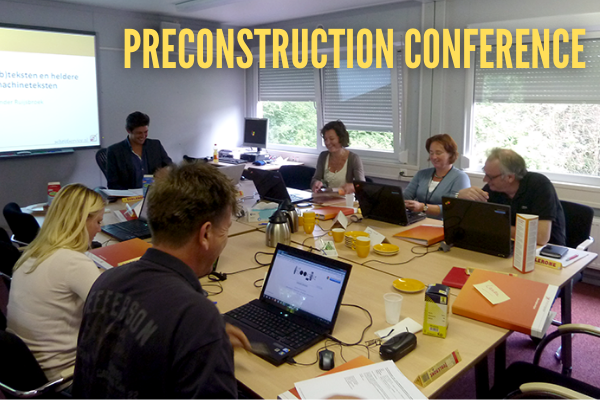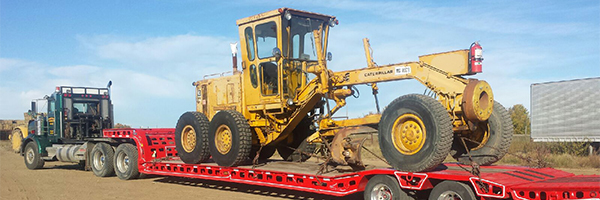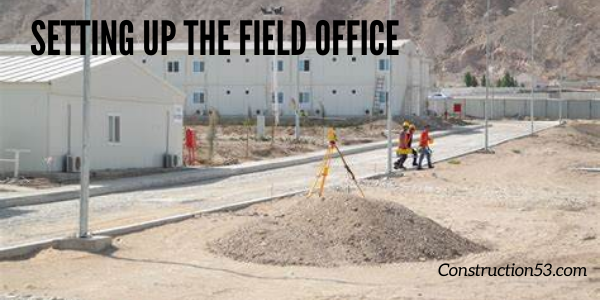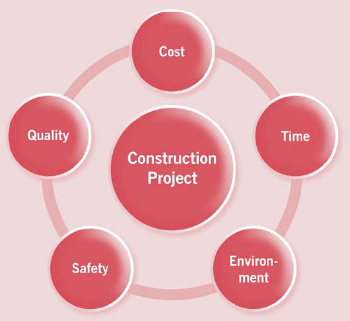Mobilization—moving onto the construction site and setting up facilities and operations for the construction of a project—is a very important time for the supervisor. It involves a series of functions and activities with which the supervisor will, quite literally, set the stage for all of the work and all of the management activities on the project. Thus, the supervisor will do well to give his or her attention to this important matter and allow sufficient time for careful planning.
HANDOFF FROM PRECONSTRUCTION TO CONSTRUCTION— HANDOFF MEETINGS
Supervisors should plan to meet with the estimators who prepared the proposal for the project and/or with those who negotiated the terms of the construction contract, prior to starting the project. Further, they should factor what they learn from these people into their own thinking, planning, and decision making. Such meetings are referred to as “handoff meetings,” where those who estimated the project cost and who assisted with contract formation hand off the project to those who will construct the project. These people will already have given a great deal of thought to the project, will have carefully examined the contract, and will have gathered large amounts of information regarding all aspects of the project. All of this information will be useful to the supervisor.
The work of the estimator was described as “building the project in his mind” and then ascribing costs to the materials and equipment to be used and to the activities to be performed. It is only logical for supervisors to avail themselves of the assumptions the estimator has made, as well as the thinking and planning that the estimator did when preparing the estimate for the project.

Supervisors may ultimately take the same approach to portions of the work that the estimator assumed or may elect to exercise a different plan w hen actually performing the work. At least, however, they have availed themselves of the thinking of this other person, so that they can then overlay this thinking with their own planning and decision making.
Additionally, it was noted earlier that the costs that the estimator has determined will form the basis for the project budget, and for all of the cost reports and the cost control measures throughout the life of the project. By meeting with the estimator before the project begins, the supervisor can gain an understanding of the manner in which these costs were determined during the estimating process.
In addition, this article has continuously underscored the importance of the supervisor's having access to, and reading and understanding, the contract for the project. Those who estimated the project and those who negotiated the contract or who sold the job will already have made a thorough analysis of all of the contract documents for the project. These people can share with the supervisor key sections or important provisions of the contract that will impact the performance of the work or that the supervisor should know about. In summary, all of the people who have been involved with the project prior to the formation of a contract can share a wealth of information with the supervisor, which will prove to be invaluable as the supervisor manages the work in constructing the project.
preconstruction conference
Preconstruction conferences are held prior to the onset of construction on most projects. At these conferences, the general contractor and his management team meet with the owner and the architect or engineer, and with all of the subcontractors and their management teams. Sometimes key suppliers are included in the preconstruction conference as well.
At these meetings, the general contractor typically introduces all of the participants. He will typically provide insight and elaboration regarding the project objectives and will emphasize important aspects of the performance of the project such as teamwork, safety, and quality. He will define certain project procedures, and will typically express his wish to have the project be a successful, and pleasant, and profitable venture for all concerned.
The supervisor should plan to attend the preconstruction conference. Moreover, she should plan and prepare for the meeting. Experience has shown that most often these meetings are what we make of them. When proper planning precedes participation at the preconstruction conference, these meetings can be highly productive and beneficial.

- Bring a schedule, or at least a preliminary schedule, to the preconstruction conference. The schedule has been defined previously as “a graphic representation of the contractor's plan for the work.” Whether the supervisor is working for a general contractor or for a subcontractor, the plan for the performance of the work should be prepared as soon as possible following the contract award and should be shared at the preconstruction conference. At the preconstruction conference, the plan for the work (schedule) that the supervisor has brought can be shared and coordinated with the schedules of the other contractors on the project. If the other contractors have not yet prepared their schedules and brought them to the meeting (as will often be the case), then the schedule of those who have planned and prepared, and who have brought their schedules with them, are often used as the beginning point in defining the plan for the project and may in fact become the basis for the project schedule. It is sometimes argued that, at the time of the preconstruction conference, there are too many variables in the planning of the work of the general contractor and all of the subcontractors on the project to warrant preparing and bringing even a preliminary schedule to a preconstruction conference. Actually, it has been shown that the opposite is true. If the supervisor is working for the general contractor, the sooner the general contractor and his or her management team prepare their schedule and begin to coordinate the plan for their work and that of all of the subcontractors, the better. If the supervisor is working for a subcontractor, the sooner the subcontracting firm's plans for the work (their own schedule for their portion of the project) can be shared with and integrated into the plan of the general contractor and the other subcontractors, the better for everyone concerned.
- Bring scope of work issues to the preconstruction conference for discussion and resolution. Given the complexity of construction projects today, and given the fact that a large number of subcontractors are typically involved in the performance of the work on the project, issues and conflicts regarding scope of work and coordination of the work are commonplace occurrences. There is no better time or place to bring these issues to the fore, and then to have them discussed and resolved, than at the preconstruction conference. As solutions and agreements are worked out, they should be written down and should be included in the supervisor's project documentation files.
- The supervisor should never attend a preconstruction conference without saying something. If the supervisor has done the planning and preparation as recommended in the steps above, it is almost inevitable that he will have something to say at the preconstruction conference. But if not, the supervisor should watch for the opportunity to offer a comment or suggestion, or to provide input regarding a matter that is under discussion. He should let his voice be heard. Not only does this provide opportunity for the supervisor to provide input, but it also gains the attention of the other participants at the meeting and establishes the fact that the supervisor and his or her company plan to be active participants in the management and coordination of the project.
- The supervisor should never leave the preconstruction conference without asking something. As noted above, if the supervisor has planned and prepared for the preconstruction conference, it is almost certain that she will have a list of questions on her agenda for the meeting. Additionally, it is certainly a commonplace occurrence that discussion at the meeting will lead to questions on the supervisor's part.
- The supervisor should ensure that she does not leave the meeting with any question unanswered. As questions are answered, the supervisor should make note, should write down the answers provided, and should include this documentation in her project files. As noted previously, the supervisor's asking questions at the preconstruction conference will not only provide her the information or resolution she needs, but will also establish among the other project participants that the supervisor and her company plan to play an active role in the planning and coordination of the project.
Some principles for maximizing the value of preconstruction conferences are outlined below. The supervisor should use these thoughts as a point of beginning in planning his participation at the preconstruction conference.
SETTING UP THE SITE
Planning is the key to success for supervisors in setting up the site. Knowing that the decisions they make and the things they do will provide the framework for all of their operations on the site for the duration of the project, should spur supervisors to give care and attention, and proper planning, to the matter of site setup.
As was noted in Chapter 11, there are numerous issues and considerations inherent in proper site planning and layout. Included is the allocation of space for the field office and for the lay-down area, for materials storage outside, as well as in a secure and protected environment, for tools and equipment, for gang boxes, for employee parking, and so forth. Planning is the key to success for all of these considerations.
It is recommended that a site plan be drawn on grid paper and that space be planned for all of the needs that the supervisor can envision during the planning for site setup. Additionally, consideration must be given to matters such as job gates for vehicles and personnel, temporary roadways, parking areas, unloading areas and turnaround areas, locks and other security features, temporary utilities, security lighting, sanitary facilities, employee break areas, employee lunch areas, and employee dressing rooms.

It is recommended that supervisors prepare a Site Planning Checklist. Such a checklist will assist supervisors in organizing their thoughts and in preparing their plan for the site setup for the project. Additionally, the checklist can be used as the basis for planning site layout and setup on subsequent projects. In this way, over a period of time, supervisors can produce a Master Site Planning Checklist. Such a checklist will not only assist in ensuring that nothing is overlooked but will also provide the added benefit of freeing supervisors from having to remember all of the elements and aspects of site planning. This will, in turn, allow supervisors to devote more of their time to the planning, analysis, and decision making regarding the project and their management of the work on it, which will be the hallmarks of their success.
SETTING UP THE FIELD OFFICE
The field office, often referred to as the “job shack,” should be envisioned by supervisors as their management headquarters for the duration of the project. Accordingly, the setup and organization of the field office merit planning and careful attention.
Careful consideration should be given to communications in the field office. Any or all of the following may be employed: wired telephones, wireless phones, facsimile machines, intercom systems, radios, and personal digital assistants (PDAs).
Additionally, computer facilities for the field office need to be planned for, and obtained, and installed. Desktop computers, laptop computers, notebook computers, and tablet computers, as well as peripheral equipment such as printers, scanners, plotters, and digital routers may play an important role in the supervisor's management plans. Other electronic devices, such as digital still cameras, digital video cameras, liquid crystal diode (LCD) projectors, and so forth, may be included in the supervisor's planning.
Along with planning for computer hardware, the supervisor should give consideration to the software that will be needed on the computing equipment at the job site. Training may be necessary for proper use of the software.
Provision for the storage, handling, and layout of drawings, specifications, and other contract documents will need to be considered. A list of contacts, organized by company, by service or product, and by person, will need to be prepared. A list of telephone numbers for emergency services (police, fire, ambulance, and medical) likewise must be prepared and posted. A bulletin board, announcement center, and message center will need to be provided.
One of the most important aspects of field office setup is the filing system that will be employed for organizing and storing project documentation and information of all kinds. The supervisor's company may have a standardized set of files and file names that the company uses for job site files. If so, the supervisor should, of course, use the company system. Additionally, the supervisor should add to it and customize it, so as to make it efficient and workable so that it meets his or her needs.

If the company does not have a set of standard files, supervisors should build a filing system of their own to meet their needs. The project manager may be able to provide insight and assistance in this regard.
The examples in Figure 17.1 are provided to assist supervisors in determining what types of files they might find useful. While not intended to be comprehensive or complete, this list will serve to provide illustrations of, and perhaps a starting point for, files and file folders that will prove valuable to the supervisor for organizing and storing the papers and elements of documentation which will be generated during the course of the performance of the project.
In a related note, it is recommended that supervisors also develop a filing system for use in their vehicle. File boxes or hopper boxes are available at office supply stores for this purpose. Such boxes accommodate a number of standard manila file folders and their contents. The supervisor's use of such a hopper box, along with the use of manila file folders labeled as appropriate and kept inside the hopper box, is highly recommended. Their use greatly facilitates organization on the part of the supervisor. Additionally it avoids the all-too-common occurrence of important papers or notes being lost or misplaced.
| PROJECT CONTRACT DOCUMENTS | SAFETY INFORMATION |
| REQUESTS FOR INFORMATION (RFI'S) -FILED BY DATE | ATTENDANCE ROSTERS -SAFETY MEETINGS |
| CORRESPONDENCE – INCOMING | MINUTES OF SAFETY MEETINGS |
| CORRESPONDENCE – SENT/OUTGOING | MSDS SHEETS |
| PURCHASE ORDERS | MATERIALS FILES – BY MATERIAL |
| PROJECT SCHEDULE AND SCHEDULE UPDATES | MATERIALS FILES – BY SUPPLIER |
| COST REPORTS | PROJECT COORDINATION MEETING MINUTES |
| SUBMITTALS LISTING | SCHEDULE OF VALUES |
| SUBMITTAL TRACKING CHART | PAYMENT REQUESTS |
| PROJECT BUDGET | DELAYS DOCUMENTATION |
| CHANGE ORDERS – BY DATE | CLAIMS AND POTENTIAL CLAIMS |
| CHANGE ORDERS – BY NUMBER |
Figure 17.1 Typical Project Files and File Names
ESTABLISHING FIELD PROCEDURES
The supervisor will need to plan for and to operationalize the procedures to be utilized in managing and controlling the project. Some of these procedures will be mandated by company policy or custom, and others may be established by the project manager. It is emphasized that beyond what the company policies require, the set of procedures for managing the project should be planned, determined, and implemented by the supervisor.
Some of the typical project procedures that should be included in the supervisor's planning and thinking are listed in Figure 17.2. These are examples of matters for which the supervisor should plan operational procedures.
The supervisor undoubtedly will encounter others that need to be handled in the course of the management of the project. When that happens, the supervisor should enter them on the Planned Procedures List so that, in time, this list can become a master checklist. It should also be pointed out that, as the supervisor makes plans for the implementation of these procedures on the project, he or she could also be thinking in terms of delegating some of these tasks.
PROJECT OBJECTIVES
All of the field procedures, and all of the management actions taken by the supervisor, should remain directed toward accomplishment of the project objectives. There are five objectives that are common to every project that the supervisor manages. These project objectives are:
- Completing the project on time
- Completing the project at or under budget
- Completing the project safely
- Providing quality in all aspects of the construction of the project
- Making the customer a satisfied client

Supervisors should recognize, and should remain mindful at all times, that the success of the projects they manage will be measured by whether or not these objectives are fulfilled. Additionally, supervisors should know that their personal and professional success will be determined by how effective they are in consistently accomplishing these five unchanging objectives.
| ATTENDANCE AND REPRESENTATION AT PROJECT COORDINATION MEETINGS | QUALITY CONTROL — ALL ASPECTS |
| VERBAL AND WRITTEN COMMUNICATIONS WITH OWNER, ARCHITECT, GENERAL CONTRACTOR, SUBCONTRACTORS | CODING LABOR ON TIME CARDS |
| ANALYZING PERIODIC COST REPORTS AND DETERMINING APPROPRIATE ACTIONS TO BE TAKEN | VERIFYING AND SUBMITTING TIME CARDS |
| ANALYZING SCHEDULE UPDATES, AND DETERMINING PLANS OF ACTION | PAYROLL CHECKS |
| PREPARING SHORT INTERVAL SCHEDULES | PURCHASE ORDERS |
| PREPARING, FOLLOWING UP ON, AND FILING INCIDENT REPORTS | VERIFYING SUPPLIER BILLINGS |
| HANDLING SUBMITTALS AND MAINTAINING A SUBMITTAL TRACKING LOG | SAFETY MEETINGS |
| ORDERING MATERIALS | SAFETY TRAINING |
| DELIVERIES OF MATERIALS AND EQUIPMENT, UNLOADING, CHECKING FOR CORRECTNESS OF THE ORDER, CHECKING FOR DAMAGE, PLACING DELIVERED ITEMS INTO TEMPORARY STORAGE ON THE JOBSITE | ACCIDENT REPORTS |
| INVOICES | DOCUMENTING NEAR MISSES |
| PREPARING AND DOCUMENTING REQUESTS FOR PAYMENT | EMPLOYEE HIRING AND DISMISSAL |
| HANDLING CHANGE ORDERS | NEW EMPLOYEE ORIENTATION |
| TOOL INVENTORIES AND TOOL SECURITY | EMPLOYEE TRAINING AND DEVELOPMENT |
| TOOL MAINTENANCE, REPAIR, AND REPLACEMENT | HANDLING EMPLOYEE COMPLAINTS |
| OBTAINING, STORING, AND MAINTAINING PERSONAL PROTECTIVE EQUIPMENT | |
| Planning and Communicating Employee Work Assignments | Equipment Repair and Maintenance |
| Monitoring the Work in Progress | Maintaining the Jobsite Filing System |
| Jobsite Communications Systems – Wired Telephones, Wireless Telephones, Intercoms, Radios, etc. | Jobsite Computer Equipment – Desktops, Laptops, Tablet Computers, PDA 's |
Figure 17.2 Examples of Typical Project Procedures to Be Planned, Determined, and Implemented by the Supervisor
SUMMARY
Some of the key points of learning that have been covered in this chapter are:
- Handoff meetings, and their value to the supervisor;
- Preconstruction conferences, and their functions, and their relevance;
- Elements of guidance for the supervisor, to help her make effective use of preconstruction conferences;
- Guidelines for setting up the construction site;
- Guidelines for setting up the construction field office;
- The importance of documentation, and of making and maintaining filing systems to facilitate effective documentation;
- Importance of properly managing field procedures, guidance to make a checklist;
- List of project objectives which pertain to every project, and emphasis on the fact that the supervisor's success will be directly related to his or her effectiveness in consistently accomplishing the project objectives.

am hydraulic mechanic from ghana seeking for employment
hydraulic mechanic from ghana seeking for jemployment